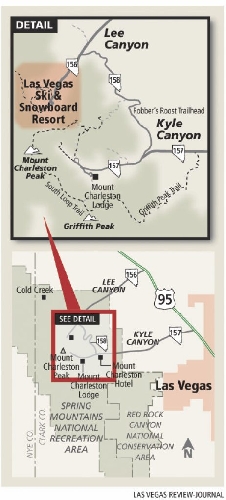Las Vegas ski resort gets OK to let it grow

The Las Vegas Ski & Snowboard Resort has won initial federal approval for a plan that would expand the ski area to at least five times its current size.
The U.S. Forest Service, which controls the resort’s land on the north face of Mount Charleston, has accepted the master plan for the site that has been in negotiation for four years. The ski area can now redevelop its current 70 acres, adding four new ski trails, installing a higher-capacity ski lift and making lodge improvements.
The approval, announced Monday, is also a major step toward a wider $35u2007million expansion of the number of trails from the current 11 to 50, addition of seven new chairlifts and expansion of the ski mountain’s footprint to nearly 500 acres. The expansion is expected to take at least a decade, with final approval coming after an environmental impact assessment that could take several years.
The resort has a long-term permit for a total of 800 acres.
“We are partnered at the hip with the Forest Service,” said resort president and general manager Kevin Stickelman. “We are with them whether the ship sinks or sails. This is an important step for us.”
Winter employment would increase from 220 to 600 upon completion, while the year-round total would rise from 10 to 30.
As part of the master plan, the resort would mitigate environmental concerns by isolating areas where the Torrey’s milkvetch plant — the natural habitat for the Mount Charleston blue butterfly — grows and try to plant it elsewhere. Environmental groups have lobbied for years to have the butterfly protected as an endangered species, because only a handful remains.
Last week, the U.S. Fish and Wildlife Service put 757 species on the bureaucratic track to endangered status in response to litigation in which the Tucson, Ariz.-based Center for Biological Diversity intervened. The blue butterfly is on that list, but the center’s local representative, Rob Mrowka, said it could take about two years to win the endangered designation.
Mrowka declined to say whether the resort expansion plan would meet the standards for protecting the blues.
“It’s hard to say at this point because we don’t have any specifics,” he said. “It could be a win-win, but the devil is in the details.”
For skiers, the noticeable changes next winter will be the four new trails, a new storage area and more outdoor seating at the lodge. The resort will put up two yurts to house youth and beginner programs.
The resort, owned by Park City, Utah-based Powdr Corp., will replace the main two-seat chairlift in 2013 with a faster three-seat model. Stickelman said the slope work would come first out of concern that increasing the lift capacity with no new skiing area could create crowding. The resort declined to disclose attendance statistics
The resort also plans to rebuild the lodge in 2013, but it is only now starting to work on plans that will include a nature interpretive center.
Although such centers are common at national parks and other preserved natural areas, Stickelman noted they are unusual for ski resorts. However, he said, the center would be staffed by Forest Service employees who would conduct guided tours in the summer.
“You would be surprised the number of people we get who show up here to take pictures of the butterflies and the deer,” he said. “And at the end of the day, it’s not a huge cost for us.”
The wider expansion of the resort will take place in stages that could take as long as 12 years to complete. No hotels or condos, common at many winter resorts, are in the plans.
Privately held Powdr bought the 40-year-old ski area in 2003. It has been the runt of the litter in a resort portfolio that includes Park City; Copper Mountain, Colo.; and Killington, Vt.
Park City, for example, covers 3,300 acres.
Contact reporter Tim O’Reiley at toreiley@reviewjournal.com or 702-387-5290.